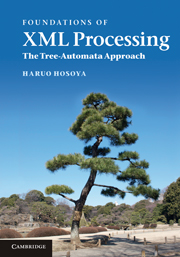Book contents
- Frontmatter
- Dedication
- Contents
- Preface
- 1 Introduction
- 2 Preliminaries
- PART I BASIC TOPICS
- PART II ADVANCED TOPICS
- 8 On-the-fly algorithms
- 9 Alternating tree automata
- 10 Tree transducers
- 11 Exact typechecking
- 12 Path expressions and tree-walking automata
- 13 Logic-based queries
- 14 Ambiguity
- 15 Unorderedness
- Appendix Solutions to selected exercises
- References
- Index
14 - Ambiguity
from PART II - ADVANCED TOPICS
Published online by Cambridge University Press: 05 July 2014
- Frontmatter
- Dedication
- Contents
- Preface
- 1 Introduction
- 2 Preliminaries
- PART I BASIC TOPICS
- PART II ADVANCED TOPICS
- 8 On-the-fly algorithms
- 9 Alternating tree automata
- 10 Tree transducers
- 11 Exact typechecking
- 12 Path expressions and tree-walking automata
- 13 Logic-based queries
- 14 Ambiguity
- 15 Unorderedness
- Appendix Solutions to selected exercises
- References
- Index
Summary
Ambiguity refers to the property whereby regular expressions or patterns have multiple matching possibilities. As discussed in Chapter 5, ambiguity can make the behavior of a program harder to understand and can actually be the result of a programming error. Therefore it is often useful to report it to the user. However, when we come to ask exactly what we mean by ambiguity, there is no consensus. In this chapter, we review three different definitions, strong ambiguity, weak ambiguities and binding ambiguity, and discuss how these notions are related to each other and how they can be checked algorithmically.
Caveat: In this chapter, we concentrate on regular expressions and patterns on strings rather than on trees in order to highlight the essence of ambiguity. The extension for the case of trees is routine and can be found in the literature.
Ambiguities for regular expressions
In this section, we study strong and weak ambiguities and how they can be decided by using an ambiguity checking algorithm for automata.
14.1.1 Definitions
Ambiguity arises when a regular expression has several occurrences of the same label. Therefore we need to be able to distinguish between these occurrences.
- Type
- Chapter
- Information
- Foundations of XML ProcessingThe Tree-Automata Approach, pp. 176 - 189Publisher: Cambridge University PressPrint publication year: 2010



